Coriander Insect Pests
Coriander Insect Pests
Whitefly
Biology:- Egg: The females mostly lay eggs near the veins on the underside of leaves. They prefer hairy leaf surfaces to lay more eggs. Each female can lay about 300 eggs in its lifetime. Eggs are small (about 0.25 mm), pear-shaped, and vertically attached to the leaf surface through a pedicel. Newly laid eggs are white and later turn brown. The eggs are not visible to the naked eye, and must be observed under a magnifying lens or microscope. Egg period is about three to five days during summer and 5 to 33 days in winter.
- Nymph: Upon hatching, the first instar larva (nymph) moves on the leaf surface to locate a suitable feeding site. Hence, it is commonly known as a “crawler.” It then inserts its piercing and sucking mouthpart and begins sucking the plant sap from the phloem. The first instar nymph has antennae, eyes, and three pairs of well-developed legs. The nymphs are flattened, ovalshaped, and greenish-yellow in color. The legs and antennae are atrophied during the next three instars and they are immobile during the remaining nymphal stages. The last nymphal stage has red eyes. This stage is sometimes referred to puparium, although insects of this order (Hemiptera) do not have a perfect pupal stage (incomplete metamorphosis). Nymphal period is about 9 to 14 days during summer and 17 to 73 days in winter (David 2001). Adults emerge from puparia through a T-shaped slit, leaving behind empty pupal cases or exuviae.
- Adult: The whitefly adult is a soft-bodied, moth-like fly. The wings are covered with powdery wax and the body is light yellow in color. The wings are held over the body like a tent. The adult males are slightly smaller in size than the females. Adults live from one to three weeks.
Life cycle:
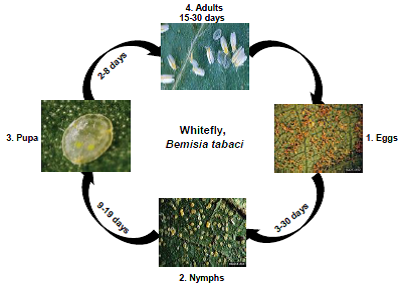
- Parasitoids: Encarsia sp., Eretmocerus mundus, Amitus aleurolobi. Platygaster sp.
- Predators: Spiders, Chelomenus sexmaculatus, Verania discolor, Coccinella septumpunctata, Harmonia octomaculata etc.
Indigo caterpillar
Biology:It is found throughout the tropical and sub tropical parts of the world, wide spread in India. Besides tobacco, it feeds on cotton, castor, groundnut, tomato, cabbage and various other cruciferous crops.
- Eggs: Female lays about 300 eggs in clusters. The eggs are covered over by brown hairs and they hatch in about 3-5 days.
- Larva: Caterpillar measures 35-40 mm in length, when full grown. It is velvety, black with yellowish – green dorsal stripes and lateral white bands with incomplete ring – like dark band on anterior and posterior end of the body. It passes through 6 instars. Larval stage lasts 15-30 days
- Pupa: Pupal stage lasts for 7-15 days and pupation takes place inside the soil.
- Adult: Moth is medium sized and stout bodied with forewings pale grey to dark brown in colour having wavy white crisscross markings. Hind wings are whitish with brown patches along the 30 margin of wing. Pest breeds throughout the year. Moths are active at night. Adults live for 7-10 days. Total life cycle is completed in 32-60 days depending on environmental conditions. There are upto eight generations in a year.
Life cycle:
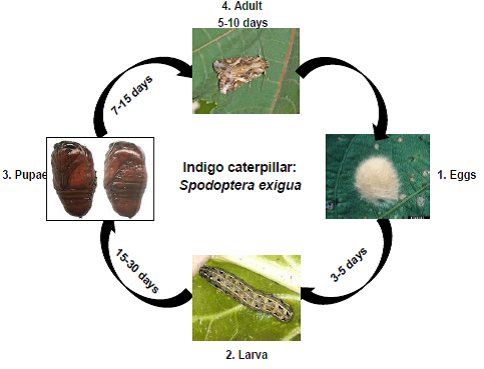
Damage symptoms:
- In early stages, the caterpillars are gregarious and scrape the chlorophyll content of leaf lamina giving it a papery white appearance.
- Irregular holes are produced on leaves initially and later skeletonisation occurs, leaving only veins and petioles
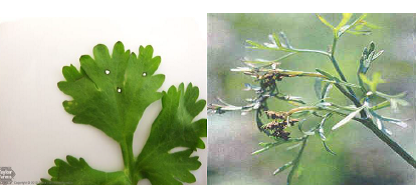
Natural enemies of indigo caterpillars:
- Parasitoids: Trichogramma chilonis, Telenomus spp., Campoletis chloridae, Peribea orbata, Glipapanteles africanus, Cotesia ruficrus, Chelonus carbonator, Blepherella setigera, Bracon spp., Sarcophaga dux , Sarcophaga albiceps, Brachimeria lasus, Lasiochalcidia erythropoda.
- Predators: Chrysoperla zastrowi sillemi, C. crassinervis, King crow, Braconid wasp, Dragon fly, Spider, Reduviid, Preying mantid, Harpactor costalis, Rhynocoris fuscipes, R. squalis , Polistes stigma, Coranus spiniscutis, Andrellus spinidens, etc
Aphid
Biology:- Eggs: Eggs are very tiny, shiny-black, and are found in the crevices of bud and stems of the plant. Aphids usually do not lay eggs in warmer parts of the world.
- Nymphs: Nymphs (immature stages) are young aphids, they look like the wingless adults but are smaller. They become adults within 7 to 10 days. Viviparity is also observed.
- Adults: Adults are small, 1 to 4 mm long, soft-bodied insects with two long antennae that resemble horns. Most aphids have two short cornicles (horns) towards the rear of the body
Life cycle:
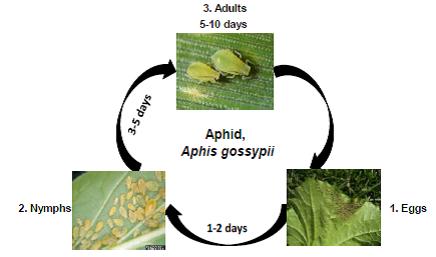
Damage symptoms:
- Infesting tender shoots and under surface of the leaves.
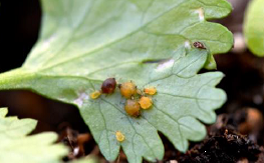
- Curling and crinkling of leaves
- Stunted growth
- Development of black sooty mould due to the excretion of honeydew
Aphidius colemani and Diaeretiella sp Predators: Fire ant, Robber fly, Big-eyed bug (Geocoris sp), Earwig, Ground beetle, Cecidomyiid fly, Lacewing, Ladybird beetle, Spider, Preying Mantid, Reduviid, Dragon fly, hoverfly, etc.
Cutworm
Biology:- Egg: The egg is white in color initially, but turns brown with age. It measures 0.43 to 0.50 mm high and 0.51 to 0.58 mm wide and is nearly spherical in shape, with a slightly flattened base. The eggs normally are deposited in clusters on foliage. Females may deposit 1200 to 1900 eggs. Duration of the egg stage is three to six days.
- Larva: There are five to nine instars, but six to seven instars are most common. Head capsule widths are about 0.26-0.35, 0.45-0.53, 0.61-0.72, 0.90-1.60, 2.1-2.8, 3.2-3.5, 3.6-4.3, and 3.7- 4.1 mm for instars one to eight respectively. Head capsule widths are very similar for instars one to four, but thereafter those individuals that display eight or nine instars show only small increments in width at each moult and eventually attain head capsule sizes no larger than those displaying only six or seven instars.
- Pupa: Pupation occurs belowground at a depth of 3 to 12 cm. The pupa is 17 to 22 mm long and 5 to 6 mm wide, and dark brown. Duration of the pupal stage is normally 12 to 20 days.
- Adult: The adult is fairly large in size, with a wingspan of 40 to 55 mm. The forewing, especially the proximal two-thirds, is uniformly dark brown. The distal area is marked with a lighter irregular band, and a small but distinct black dash extends distally from the bean-shaped wing spot. The hind wings are whitish to gray, and the veins marked with darker scales. The adult preoviposition period is about seven to 10 days.
Life cycle
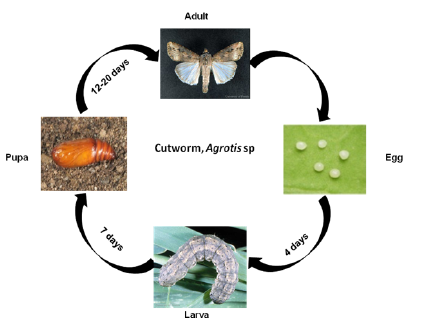
Damage symptoms:
- The larva cuts the plants from ground level and makes them to fall down. Infestation of this pest starts at the initial stage of plants resulting in heavy loss to the crop.
- Parasitoids: Apanteles merginiventris, Chelonis insularis, Hyposoter exigua, Chelonis insularis, Lespesia archippivora.
- Nematode: Hexameris arvalis
- Predators: Broscus punctatus, Liogryllus bimaculatus.
Thrips
Biology:- Egg: Eggs are microscopic and white or yellow in color which is inserted one by one in the plant tissues by the females. Only one end of the egg will be near the surface of the tissue to allow the immature to emerge. Adults prefer to lay their eggs in leaf, cotyledon or flower tissues.
- Nymph: Nymphs are very small, pale yellow to brown in color and the pupae appear as an intermediate form between the immature and the adult. Nymphs have short antennae and the wing buds are visible but short and not functional. They are found at the base of the plant neck or in the soil.
- Adult: Adults are up to 2 mm in size, pale yellow to dark brown in color and have fully developed wings which are very different from other insects. They have a single longitudinal vein in which there is several hairs connected perpendicular to the vein. The wing appears as fringe with hairs. When at rest, the wings are folded along the back of the insect... Besides undersurface of leaves, they can also be found in the flowers. Adults are more mobile than immature and are attracted to yellow and white colors. They often alight on one's clothes or on 34 exposed skin.
Life cycle:
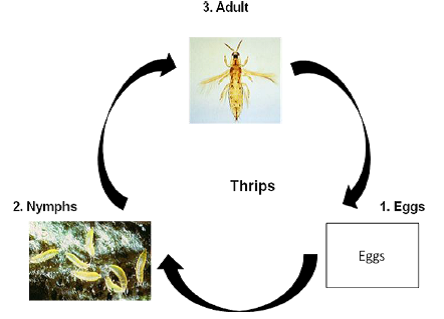
Damage symptoms:
- Thrips have a very peculiar feeding behavior. They start the feeding by rasping and sucking and they lacerate the leaf surface with their mouth parts to release the liquids from the plant cells. In this process, thrips release chemicals substances that help to predigest the cell sap. Which they suck up.
- The damaged leaves show silvery patches or streaks that shine in the sun. When damage is severe, these small patches can occupy most of the surface of the leaf and the plant cannot adequately photosynthesize. The plant loses more water than normal through the damaged tissues which are the entry points for plant pathogens.
- Parasitoid: Ceranisus menes
- Predators: Predatory mite, Predatory thrips, Oligota spp., Orius spp. (pirate bug), Hover fly, Mirid bug, etc.
Mites
Biology:- Egg: Eggs are microscopic, hyaline, globular, laid in masses beneath clods and are either active (red in colour) or dormant (iwhite in colour).
- Nymphs: Yellowish in colour
- Adult: The mites are very small measuring about 0.5 mm in length, metallic brown to black with 35 pale yellow legs. Their forelegs are distinctively longer than the other three pairs
Life cycle:
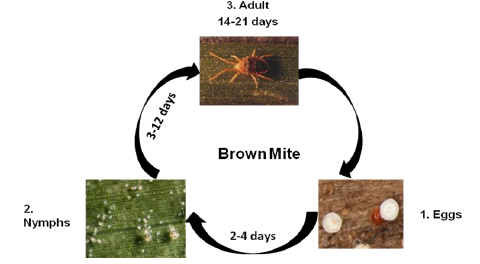
- The mites frequently attack the coriander crop and whole plant
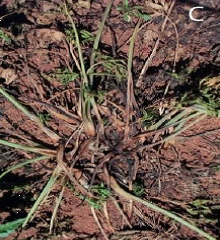 becomes whitish yellow and appears sickly. It mostly feeds on young leaves and the infestation is more severe on young inflorescence.
becomes whitish yellow and appears sickly. It mostly feeds on young leaves and the infestation is more severe on young inflorescence. - Mites are seen on the lower side of the leaves and when serious, cause webbing and feed from within the web. Plants get stunted at severe infestation.
Predators: Anthocorid bugs (Orius spp.), mirid bugs, syrphid/hover flies, green lacewings (Mallada basalis and Chrysoperla zastrowi sillemi .), predatory mites (Amblyseius alstoniae, A. womersleyi, A. fallacies and Phytoseiulus persimilis), predatory coccinellids (Stethorus punctillum), staphylinid beetle (Oligota spp.), predatory cecidomyiid fly (Anthrocnodax occidentalis), predatory gall midge (Feltiella minuta), Predatory thrips etc.
Root knot nematode
Biology:- Most species of plant parasitic nematodes have a relatively simple life cycle consisting of the egg, four larval stages and the adult, male and female.
- Development of the first stage larvae occurs within the egg where the first moult occurs. Second stage larvae hatch from eggs and infest plant roots or in some cases foliar tissues.
- Under suitable environmental conditions, the eggs hatch and new larvae emerge to complete the life cycle within 4 to 8 weeks depending on temperature.
- Nematode development is generally most rapid within an optimal soil temperature ranging from 39-450 C.
Life cycle:
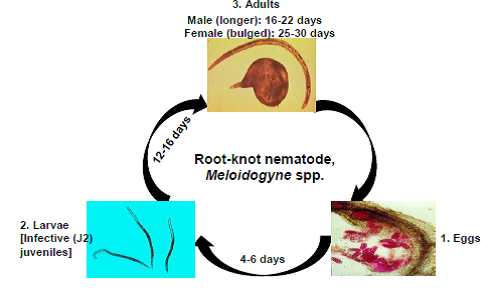
- Infested plants appear in patches in the field
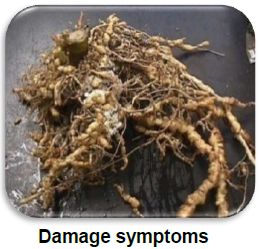
- Formation of galls on host root system is the primary symptom
- Roots branch profusely starting from the gall tissue causing a ‘beard root’ symptom
- Infected roots become knobby and knotty
- In severely infested plants the root system is reduced and the rootlets are almost completely absent hampering their function of uptake and transport of water and nutrients.
- Plants wilt during the hot part of day, especially under dry conditions and are often stunted.
- Nematode infestation predisposes plants to fungal and bacterial root pathogens.
- Primary: Egg masses in infested plant debris and soil or collateral and other hosts like Solonaceous, Malvaceous and Leguminaceous plants act as sources of inoculum. Secondary: Autonomous second stage juveniles that may also be water dispersed.
- Secondary: Autonomous second stage juveniles that may also be water dispersed.
Loamy light soils.
IPM for Coriander
To know the IPM practices for Coriander, click here.
Source: NIPHM Directorate of Plant Protection, Quarantine Storage
Last Modified : 3/23/2020
This topic covers information about Description of...
This topic covers information about Chilli insect...
This topic covers information about Fig insect pe...
This topic provides information about Cherry- Inse...
